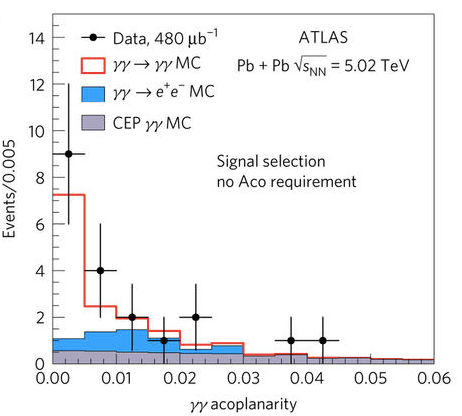Particle accelerators have a lot of important jobs, such as looking for new stuff by slamming beams of old stuff together. But a new particle accelerator observation has managed to be important while doing almost precisely the opposite of what we’d expect. Physicists have found evidence for hard-to-detect stuff by, well, not slamming particles together.
Image: ATLAS Collaboration/CERN
Here’s what I mean: By taking advantage of the electric charge of ions, or atoms sans electrons, a team of physicists at the ATLAS experiment of the Large Hadron Collider in Geneva Switzerland have found direct evidence that photons, or particles of light, scatter off of each other. Classical high school physics expressly forbids this from happening, but the quantum mechanics theory governing light particles has since determined it should. But directly measuring high-energy photons scattering off of each other, has been a real difficulty. Until now, of course.
“You’re just looking at two photons colliding and two coming out, and nothing else,” Peter Steinberg, physicist at Brookhaven National Labs and part of the ATLAS collaboration, told Gizmodo. “These are spectacular measurements from this program.”
If you remember high school physics, two light waves should superimpose onto one another into one wave when they come into contact. But light, in its smallest unit, can also act as a particle. While studying how electromagnetism works for individual particles, physicists realised that photons could come into contact with one another, exchange information, and then scatter. The challenge became how to detect such a process.
Other experiments have observed the scattering, but at lower energies, with some caveats, and only indirectly (they hadn’t sent two photons in and seen two photons come out). But with the high-energy beams of the Large Hadron Collider at their disposal, physicists at the ATLAS experiment had the opportunity to observe the phenomenon directly, and published their results in Nature Physics yesterday (though I’ll note they have been available on the arXiv for a little while).

Here’s the discovery plot. All you have to know is that the black cross all the way to the left is the data point that shows the photons have been behaving the way the physicists were hoping.
The Large Hadron Collider is likely more well known for colliding beams of protons together — this is how researchers found the Higgs Boson. But that calculation is muddier, with more protons colliding at the same time. The new discovery instead came from the collider’s heavy ion run, which collides lead atoms stripped of their electrons. The physicists look at data where the colliding beams of lead completely miss one another, so instead, just the high-energy photons are left to interact. The particles exchange information with one another via a sort of fluctuation in space, and shoot off in opposite directions, if you look lengthwise down the ATLAS cylinder (as shown in the lower lefthand corner of the above image).
I guess it’s like a crowd of runners running by each other and throwing rocks at each other, as opposed to a couple of elephants running by and throwing boulders at each other. Sort of.
“The large electric charge is a great feature of ions that are otherwise mostly used for their large amount of nucleons,” André David, a scientist for ATLAS’s rival CMS group, told Gizmodo in a Twitter direct message. That means they’re useful for this kind of physics that only requires the force particle of electromagnetism: Photons.
Photons scattering off each other is also something physicists expected to find. “This result is interesting but not really unexpected. Quantum Electrodynamics is one of the best-established theories in physics, and this phenomenon (photon-photon interaction) was expected. The surprise would have been not observing it,” Joao Varela, another scientist at CMS, told Gizmodo in an email.
It’s still a big deal. “Of course it was an enormous experimental success to make the observation,” he said. But it’s important to note that the researchers only observed a 4.4 sigma signal over the background noise. That means that despite the difficulty in making the measurement, more data is required to hit the five-sigma benchmark particle physicists require to announce a true discovery. And this difficult discovery came from only 13 candidate events, from over four billion total events in 2015, according to the CERN press release.
Once the discovery happens, though, these photon-photon scattering events can be used to help discover all sorts of crazy potential physics, such as new particles, magnetic monopoles… who knows.
“We need more data to address that stuff,” said Steinberg. But once we get there and once we can set up the right experiments, “it’s a whole zoo.”
